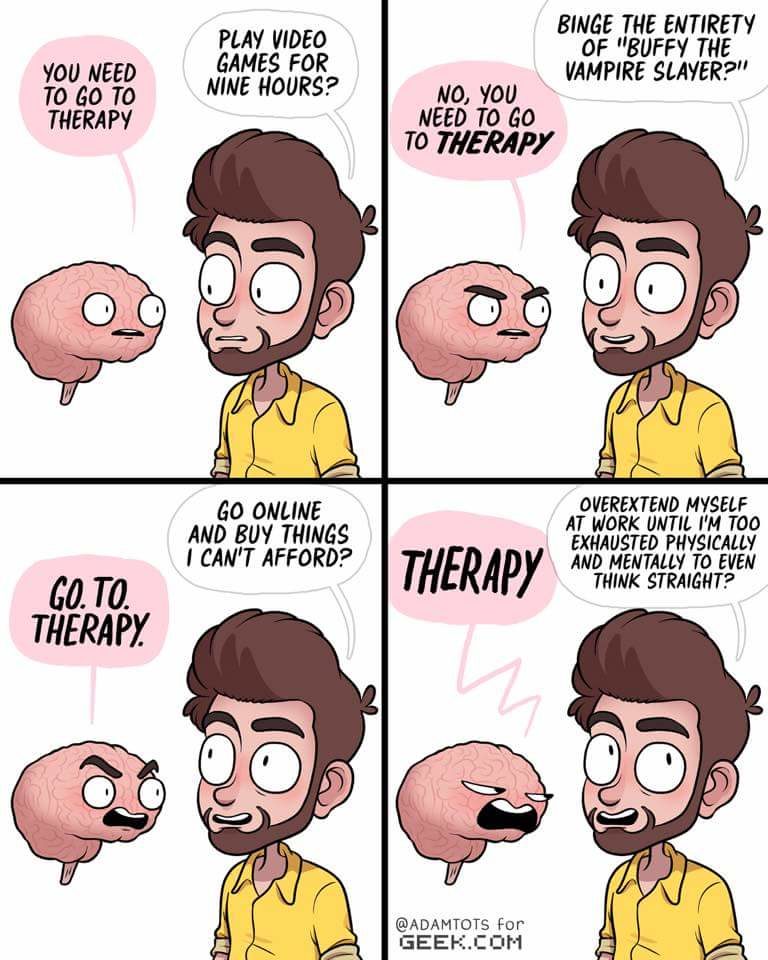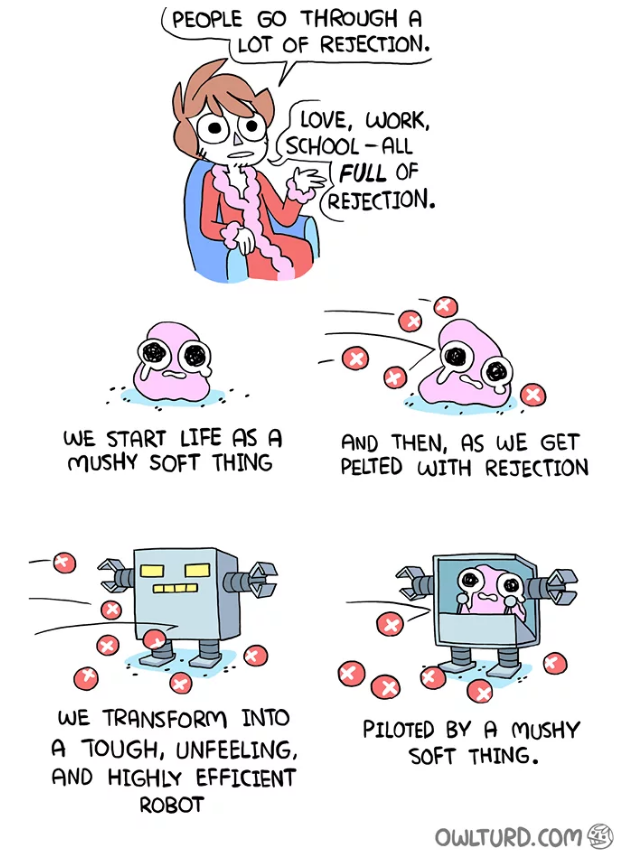I’ve wanted to write about masculinity for a while. I often hesitate about sharing such things because the discourse around it is so volatile. There were two things that got me off my ass.
First was Andrew Tate. Seeing him pop up in my feed, hearing people discuss him as if he says anything even remotely new and unique — it makes me ill.
Second was a text message. It was from a high-level black belt in the jiu jitsu community I’m a part of. He didn’t even send it to me, but it was shared with me by multiple people who did get it. It was a “holiday” message about how people want us to be weak and docile but we should reject that, and instead be monsters and “learn how to control it.”
I have to say, fuck that noise. I’m so tired of being told how to walk, talk, think, act, and dress. Over my life I’ve dealt with bullshit male criticism over the music I listen to, the food I like, the way I cut my hair, how I laugh, how well I enunciate my words, and even the fact that I enjoy being affectionate with my wife.
What does another person’s private joys have to do with being a man? Nothing. Nothing at all. The people who invest their energy making others feel bad about who they are are not acting in the capacity of masculinity, but rather as insecure children.
I’m approaching middle age, and I’ve been seeing this hyper-masculine caricature play out for my entire life. And I’m just so damn bored by it. The caricatures never have anything new to say or offer, they just repackage the same old violent, aloof garbage that’s been going on since before you were born.
But Tate isn’t the problem. Neither was Tucker Max before him, or The Game by Neil Strauss. They’re all just symptoms.
The actual problem is boys who need help and guidance, but aren’t getting it from any other source. They don’t have anyone teaching them solid communication skills. Media representations of men focus on muscles, mockery of others, taking whatever we want right when we want it, physical violence, emotional manipulation, fucking as many people as possible, making lots of money and showing it off.
Lost boys flock to this kind of philosophy because it’s simple to understand. Loud, shameless, baselessly chauvinistic, completely lacking in nuance — this is the default mode. Just go with how things have been done for centuries. Misogyny is EASY. This is why the most vulnerable minds just eat it up. When we’re hurting and frightened, we don’t care about real solutions — we just want the pain to stop.
The boys who follow the Andrew Tates of the world are not necessarily bad people, just scared and lazy. They want simple things, quickly. Like sex, money, and power. They aren’t complicated — but they’re young and don’t yet understand the impact of their behaviors, the smallness of their aspirations, or how vulnerable their desperation makes them. Desperate people make bad decisions — that’s just the way it is.
These boys need direction because they feel inadequate, afraid, frustrated, lonely, rejected, or any combination of those. They need someone to tell them it’s okay, and they’re willing to listen to anyone who can make them feel that — even if it’s just a fantasy.
I can’t promise that everything will be okay for you, because it absolutely depends on YOU. I can promise that if you want things to be better, the potential is there. It’s possible. But no, it’s not going to be easy. There is no one-size-fits-all solution. Expensive cars won’t solve your problems. Treating women like shit won’t solve them, either. Investing in crypto and using terms like libtard also have nothing to do with masculinity.
If you want your life to be better, you’re going to have to work at it. And the work is not going to be glorious or quick. Most frustrating of all, the work will never be over. You will never reach a point where you have learned it all. This is one of the most frustrating parts of misogyny for me: this idea of “arriving.” If you just fall into line about the cultural standard definition of manhood, you’ll be whole and complete and won’t need any more tune ups, ever.
It’s a racket. They don’t want to “fix” you — they just want you to shut up. Your compliance as a Default Man is more valuable to them than an independently-thinking version of you. A sincere and curious person never stops developing — they are always on a journey.
I want to stay away from this flawed idea of a “real man.” Instead, I want to encourage you to continuously scrape off such scummy thoughts and spend more time reflecting on what you, the individual, wants your manhood to look like. (Because I’m willing to bet that most — if not all — of what you think of as “manly”)
This is called self-alignment, and it’s where I want to start this little masculinity project of mine. Self-alignment is when your thoughts, words, and actions line up with your values. If, for example, you consider honesty to be a core value, and yet you spend a lot of time lying and deceiving others — your self-alignment is off. Which likely means you will have a low hum of discomfort at all times. You see, self-alignment is a central tenet of a person’s overall happiness. If you cannot get in alignment with your values, you’re imposing misery on yourself.
There are two ways out of this. The first (and easiest) is what people usually do: bend or break their values. They seek out excuses, explanations, and technicalities so they don’t have to examine the rift within themselves.
The second way out is to alter your own behavior to align with your values. This is the harder, less sexy option — because it takes time. The sort of person who takes this route won’t be posting pictures of their expensive cars and clothes. They don’t need to be center stage, making a lot of noise. They care little about seeking approval from strangers, because they can feel in their bones that who they think they are is at least pretty close to who they actually are.
If you want to understand your own self-alignment, write down a short description of how you aspire to be. Now share it, one at a time, with the people you know. Your parents, friends, co-workers, and even former lovers. Ask them if you’ve accurately portrayed yourself, and if your lifestyle seems to reflect that you’re headed towards your own stated goals. Here’s the real challenge: you can’t question, comment, or complain about anything they say in response. In fact, tell them from the start that you won’t.
See, if you have to explain who you are to someone who already knows you, that means you haven’t actually demonstrated those values. If someone who knows you well raises an eyebrow at your self-assessment, you are likely wrong about yourself.
This is a tough exercise. If you’re doing it right, chances are high that you’ll either feel angry/defensive at some of the responses — or you’ll feel incredibly humbled. Maybe even shocked.
If you’re in the angry/defensive phase, that’s fine. But just sit with it a bit. Don’t lash out. Roll it around in your brain, and don’t let yourself get away with criticism of that other person — even within your own thoughts. Keep rolling it around until humility sets in.
Once you feel that humility, or if you felt it from the start of the exercise, you have created fertile ground to start asking questions and making a plan for how to become more aligned. As I said, there is no one-size-fits-all plan. Your journey is your own. But there are some first steps that any frustrated male can take if they truly want to improve their lives in a lasting way.
Some of those steps are: improving your communication, empathizing with others, recognizing and reducing selfish impulses, and being willing to listen and practice. The answer is not “keep doing what you’re doing,” and it’s definitely not “double down.”
Trust me on this. I spent decades letting my anger get the better of me. I partied a lot, had plenty of meaningless sex, constructed a life full of low-grade pleasures. As my hair started graying in earnest, I had nothing to show for my efforts. Just a whole lot of former friends and lovers who got sick of my bullshit and understandably sought out better people to be around.
I got left behind. Chances are if you choose an eternal boyhood you’ll find it quite lacking, too.
I’m a flawed man, with a trail of mistakes that I’ve been slowly coming to terms with for years. I want to be better, and I hope that in sharing my experiences I can help others to be better, too. I have no illusions that I can develop a following with this sort of approach, because I think humans will always have a majority preference for a quick solution over an effective one that takes work. But if there are even just a small handful of basically good-hearted young men who are interested in an alternative to the same old nonsense that the misogynists have been promoting forever — I’m trying to figure that out, too.
Let’s talk. Let’s figure this out.






